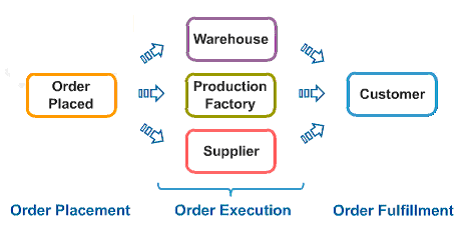o deal with the driving trends, companies are forced to change the way they handle the supply chain. In the real-time supply chain, order data are shared among supply chain partners using integrated information systems and high-speed communication infrastructure. The parallel access to the order data allows collaboration and coordination of supply chain activities.

In the figure above (from S. Boyson, T. Corsi, eCourse; Managing the real-time supply chain, introduction module), the sequential manner of doing business is made clear. Two situations are possible. In a made-to-stock supply chain the order proceeds directly to the warehouse for fulfillment. The order will be picked from the stock and prepared for transport. Now the production factory will be notified of the change in stock and in result replenishment is necessary. In the situation of made-to-order the order goes to the production facility. Production planners need to check raw material inventory and possibly contact suppliers to procure additional material. Every time period the forecast is adjusted based on actual demand and suppliers receive the new forecast to adjust theirs. The finished products are finely shipped to the customer.

The figure above gives an image of the real-time supply chain. After the customer submits the order all parties are informed parallel. Due to integrated information systems and high-speed communication infrastructure, the inefficiencies will be addressed. In a real-time supply chain, the customer will order via an Internet web site. Automatically manufacturing and production systems are triggered to inventories, and a prediction is made when the product can be ready. The direct communication goes beyond the focal company to suppliers for automatic reordering and possible alternative suppliers are contacted. The forecasts are adjusted immediately on the actual orders. The customer is provided with up-to-date information about the status of the order.
By effective coordinating and communicating, all supply chain partners will benefit from real-time supply chain management. This new approach is enabled by new technologies. The combined innovations in telecommunication and applications have allowed the emergence of real-time supply chains. The motivation behind the real-time supply chain is to let the supply chain serve the customer.
Literature
Boyson, S., T. Corsi, M. Dresner and L. Harrington, Logistics and the Extended Enterprise: Benchmarks and Best Practices for the Manufacturing Professional, John Wiley & Sons, 1999.
Boyson, S., L. Harrington, and T. Corsi, In Real Time : Managing the New Supply Chain, Praeger Publishers, 2004.


